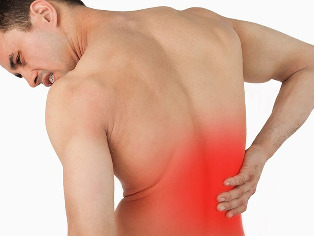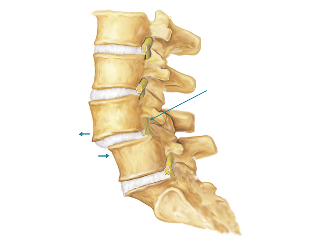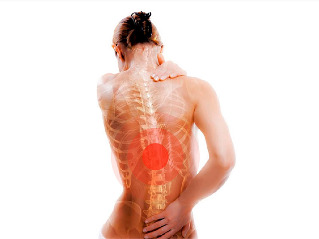Many sore backs and very different, from the moment that this happens with most of the adults. Someone pain is not a sign of anything serious, just need to do some simple exercises to pass on. Someone turns into a symptom of a tumor, infection or degenerative changes of the spine.
To understand what causes the pain, how it happens and what to do with the that is not that difficult.
The causes of back pain

Why the back pain? The causes of back pain are very varied. Describe them the easiest way to divide in groups.
- Temporary. The syndrome occurs in otherwise healthy people for a short period of time, as a result of exposure to adverse circumstances, the abuse of physical activity, prolonged standing in one position. Not dangerous, just to get rid of'.
- Degenerative diseases. Appears as a result of changes in the spine: the vertebra has shifted, problems with intervertebral disks that pinched a nerve. Not dangerous, but unpleasant and has a long period.
- Infectious. It becomes the symptom of the inflammatory process that takes place to the spine or surrounding muscles. Dangerous, because the infection affects the entire body negatively and can lead to the death of the patient.
- Radiant. It becomes the symptom of the disease of internal organs. The spine is not affected, the pain only goes to the back.
- Other. This group combined reasons, which are not included in the first four.
Understanding of why the back pain must be directed at each group separately.
Temporary pain
It is a small group, but with them has an opportunity to confront any person. The reasons have three:
- Awkward body position. Back pain is a natural reaction to the muscle tension and bad curvature of the spine. Persistent pain, unpleasant. Typical of people who work sitting several hours, the creation of a comfortable work space, with a long stay in one position.
- A muscle strain. If an untrained person begins to carry heavy loads, take part in active work or go to the gym, the reaction of its muscles and ligaments is natural the next day, he suffers from pain. His character-drawing is reinforced when you try to move. If you continue to strain, can bring the muscle of the inflammation.
- Pregnancy. In order for the baby to exit the birth canal, already in the first months of pregnancy, a woman's body begins to produce a hormone that ligaments soft. At the same time, the longer the duration, the greater the child's weight and the load on the spine results nagging persistent pain localized in the lower back or sacrum.
Back pain of this type are themselves the muscles are restored, a child is born, the position of the body changes and everything returns to normal with little input from the patient.
All you can do to relieve your condition, offering you a time to rest.
Degenerative diseases of the pain

This problem is more serious than temporal, and if same does not happen. These include:
- Low back pain. The reason for degenerative changes in the structure of the intervertebral discs. Lose their elasticity and become flat, causing the vertebrae to become less mobile, crumble, change shape. To distinguish, depending on the affected regions of the spine: cervical, thoracic, lumbar. The neck is accompanied by pain which give to the shoulder, painful headaches, dizziness, hearing impairment. Breast given breast, often so much so that there are problems with the breathing. Lower back radiates to the legs, often accompanied by limp, and disorders of the pelvic organs.
- Intervertebral hernia. Hernia develops when the intervertebral disc bulges between the vertebrae. In the beginning the pain is dull, nagging, increases when the disk presses the vertebrae when the patient coughs, lifting weights, always sitting in one place. In the future, increases, it starts to give in the limbs, becomes acute. Accompanied by weakness of the muscles, rapid change of position for the worse, problems with the sensitivity of the extremities. If it is left untreated, it can lead to the complete paralysis of everything below the disc that pinched.
- The displacement of the vertebra. Developed either congenital abnormalities or degenerative changes in the structure of the spine. Often localized in the lumbar region, pain is constant, nagging, comments in the buttocks and legs.
- The herniated disc. Becomes logical continuation of the development of a herniated disc. Pinched disc bulges so that, in reality, falls from his seat. For the condition characterized by acute pain the patient is frozen in a position and trying very hard not to move, not to aggravate.
- Sciatica. Occurs due to entrapment of the spinal roots. It is manifested by pain, and then tingling, numbness, reduced sensitivity of up to complete atrophy of the plot, the connection with the nervous system provides a particular sport. Because of the sciatica is caused lumbago pain syndrome in which the patient suddenly shoots up again and it freezes in a bent position, unable to straighten.
- Osteoporosis. Occurs, either by age or by hormonal disorders in the body. Bone tissue, as a result of the disease, becomes less dense and loses its structure normal. Pain during a long stay in a posture static or when the weather changes. They are accompanied by a change of posture, leg cramps and the extreme fragility of the bones of any weak shock can lead to a fracture.
- Bechterew's Disease. Disease that leads to weakening of the small joints of the spine, the connection of individual vertebrae. It is characterized by constant pain, which increases at night and makes it easier in the morning.
Degenerative changes are chronic and are treated primarily by lifestyle changes and manual therapy. Symptomatic therapy is only administered at the time of relapse, surgery is indicated only in cases of osteochondrosis, for example, that does not help.
Infectious
Specific to inflammation of the spine, not so much for the greater part of the syndrome is due to infectious diseases, which can, in principle, be localized in any place. More often it is of two diseases:
- TB. The lung form is the most common, but also happens that affects the spine. Pain painful, treatment is long and difficult, often the person keeps the results valid.
- Osteomyelitis. Affects the bone, the periosteum, bone marrow. Cums hard, with the formation of pus. Persistent pain, accompanied by the formation of fistulas, wounds festering in the body.
And tuberculosis, and osteomyelitis are accompanied by a fever, headaches, muscle weakness, fatigue, and often also nausea, vomiting, diarrhea all these are classic symptoms of the infection. The treatment you require immediately, because the previous phase to make it more effective.
Radiant

Diseases of internal organs can also cause pain. This pain is not increased and is not reduced by changing the position of the body, and is also accompanied by clear symptoms that point to an organ-specific.
- The kidneys. The most common variant, often in inflammatory diseases or with gems. Girdle pain at the level of the waist, more powerful, again, not. Accompanied by frequent urination and intense yellow color of urine or blood, fever. Sometimes found in the form of renal colic sharp pain in one side of the back.
- The digestive tract. Ulcer or gastritis pain may be given on the back. Nature pain, occur either in the afternoon, when the man goes to sleep, or when hungry, or immediately after a meal. Accompanied by symptoms classic of indigestion and intestinal bloating, increased gas, nausea, constipation or diarrhea. Sometimes, there is the acidity and the blood in the stool black, if the patient has an ulcer of the stomach, and black, if the ulcer of the intestine.
- Gynecology. Women are also pain pain in the nature, located just above the waist. This is accompanied by alterations of the menstrual cycle, secretions of unusual color and texture, with an unpleasant odor, problems during intercourse, sometimes a high temperature.
- Lungs. Stabbing pain in the spine thoracic, the increase in the inhalation, the exhalation weakens. Accompanied by shortness of breath, shallow and rapid breathing, symptoms of oxygen starvation, fatigue, dizziness, fainting.
- The heart. A stabbing pain, also in the chest, can occur in the shoulder and arm of the left. Accompanied by arrhythmia or tachycardia, shortness of breath, dizziness.
In this case, pain syndromes easily in contact with the internal organs, because when regular pain in the back, there are more symptoms that are observed.
Other
This group includes diseases such as malignant tumor and back injuries, which were not included in the above. They are characterized by different symptoms:
- Tumor. Cancer in the spine is located only on rare occasions, then, is affected, or bone marrow or bone tissue. Often back is full of metastasis, and then, in addition to the main symptoms that the patient suffers also from a severe pain in the back.
- The injury. Drop, shock, and other injuries leave a bruise, sometimes broken ribs or even the spine. And the symptoms and treatment are very dependent on the nature of the injury in which a vertebra came to the young man. More often, the consequences range from simply wait for a bruise to go to the hospital and a long wait until the bones grow together.
In any case, these causes are serious and require a visit to the doctor, diagnosis and treatment.
Types of pain
Back pain is often different to assume that the problem is, simply by its nature. Screening:
- strong pulling is characteristic of degenerative changes, or, if accompanied by symptoms of heart or lung disease;
- acute occurs when sciatica, prolapsed vertebral, renal colic and infections often accompanied by fever;
- nagging often caused by muscle tension (and then the muscles in the palpation solid, reduced), but may be evidence of degenerative changes in the acute phase, if the back pain permanent;
- radiating back pain symptoms are accompanied by symptoms from other organs, the pain does not change the intensity or, depending on the position of the body, or, depending on the time of day.
If the back pain, pain says a lot about the that is affected. Sometimes you don't even need a doctor visit and you can understand yourself.
What to do for back pain?

There are some cases in which to go to the doctor don't have:
- if the disease is chronic and that the patient had not time;
- if the pain results from muscular overstrain;
- if the patient was sitting in an awkward position and clearly associated with this pain.
In these cases, it is enough to keep the place that hurts warm (you can wrap it with a scarf), to avoid postures uncomfortable and take vitamins that help the body to recover faster.
Immediately appointment with the doctor or to call home, you need if:
- the pain came after the injury;
- the pain was accompanied by the loss of sensitivity of the back and limbs;
- the pain persists for several days or even improved;
- it is accompanied by fever and other symptoms of the infection;
- the pain persists, even if you stretch out and relax;
- the pain is accompanied by additional symptoms of tachycardia, shortness of breath, problems with urination, constipation or diarrhea.
The doctor must visit if your back pain pain of a child or elderly person over the age of fifty years.
Diagnosis
Diagnosis is carried out sequentially after the consultation where the doctor will ask the patient about symptoms and carry out the palpation, a variety of tests to understand what could lead to back pain.
Among them:
- General blood and urine gives an idea about the status of the body, and also to detect infectious contamination, if necessary;
- the x-rays suitable for the detection of tumors and tuberculosis, gives an idea of the shape of the spine and its deformation;
- The ultrasound and the MRI are used to obtain more detailed information of the image of the spine.
After receiving the results of the examination, the doctor may have to assume that was the cause of this condition and to assign more specialized tests. A biopsy, which show that the processes are found in the tissues neurological tests, showing the depth of the lesion, infectious cultures, the identification of the causative agent.
As a result, the range reduced so that the cause of this disease will become apparent and you can proceed to treatment.





































